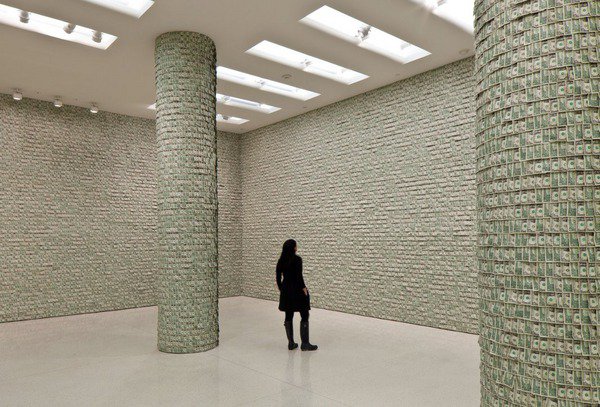Hans-Peter Feldmann
dal 19/5/2011 al 1/11/2011
Segnalato da
19/5/2011
Hans-Peter Feldmann
Guggenheim Museum, New York
Feldmann, winner of the Hugo Boss Prize 2010, is the 8th artist to win this prestigious biennial award to recognize significant achievement in contemporary art. Composing images and objects into serial archives, uncanny combinations, and other illuminating new contexts, his work unearths the latent associations and sentiments contained within the landscape of daily life. The installation, which uses money that has previously been in circulation, extends the artist's lifelong obsession with collecting familiar material into simple groupings that reveal a nuanced play of similarity and difference.

An exhibition of the work of German artist Hans-Peter Feldmann (b. 1941, Düsseldorf), winner of the HUGO BOSS PRIZE 2010, will be on view at the Solomon R. Guggenheim Museum, May 20–November 2, 2011. Feldmann is the eighth artist to win this prestigious biennial award, established in 1996 by HUGO BOSS and the Solomon R. Guggenheim Foundation to recognize significant achievement in contemporary art.
Feldmann has spent over four decades conducting a profound investigation into the influence of the visual environment on our subjective reality. Composing images and objects into serial archives, uncanny combinations, and other illuminating new contexts, his work unearths the latent associations and sentiments contained within the landscape of daily life. As the 2010 prizewinner, Feldmann received an honorarium of $100,000, and for his solo exhibition at the Guggenheim, he has chosen to pin this exact amount in overlapping one-dollar bills to the gallery walls.
The installation, which uses money that has previously been in circulation, extends the artist’s lifelong obsession with collecting familiar material into simple groupings that reveal a nuanced play of similarity and difference. Throughout his practice, Feldmann has frequently demonstrated the impulse to divide an apparent whole into separate components; he has photographed every item in a woman’s wardrobe (All the clothes of a woman, 1973), presented individual images of the strawberries that make up a pound of fruit (One Pound Strawberries, 2005), and created a sequence of 100 portraits showing individuals of every age in a collective lifespan of a century (100 Years, 2001).
Feldmann also has a history of resisting the art world’s commercial structures, issuing his work in unsigned, unlimited editions and at one point retiring from art making altogether for nearly a decade in the 1980s. Bank notes, like artworks, are objects that have no inherent worth beyond what society agrees to invest them with, and in using them as his medium, Feldmann raises questions about notions of value in art. But his primary interest in the serial display of currency lies less in its status as a symbol of capitalist excess than in its ubiquity as a mass-produced image and a material with which we come into contact every day. At its core, this formal experiment presents an opportunity to experience an abstract concept—a numerical figure and the economic possibilities it entails—as a visual object and an immersive physical environment.
Hugo Boss Prize 2010: Hans-Peter Feldmann is organized by Katherine Brinson, assistant curator, Solomon R. Guggenheim Museum.
In November 2010, Feldmann was selected as the prizewinner from a shortlist of finalists that included Cao Fei, Roman Ondák, Walid Raad, Natascha Sadr Haghighian, and Apichatpong Weerasethakul. The award is given to an artist whose work represents a significant development in contemporary art and sets no restrictions in terms of age, gender, race, nationality, or medium.
The jury for the 2010 prize was chaired by Nancy Spector, Deputy Director and Chief Curator, Solomon R. Guggenheim Foundation, and the jurors were Udo Kittelmann, Director, Nationalgalerie, Berlin; Alexandra Munroe, Samsung Senior Curator of Asian Art, Solomon R. Guggenheim Museum; Yasmil Raymond, Curator, Dia Art Foundation, New York; Joan Young, Associate Curator of Contemporary Art and Manager of Curatorial Affairs, Solomon R. Guggenheim Museum; and Tirdad Zolghadr, independent writer and curator. In the official award statement, the jury described its selection: “A key influence on generations of younger artists, Feldmann’s work exhibits a vitality and keen originality that places it among the most compelling work being produced today. It is this critical engagement with the moment that we recognize in awarding him the HUGO BOSS PRIZE 2010.”
Publication
In conjunction with the HUGO BOSS PRIZE 2010, the Guggenheim has published a catalogue that explores the work of the 2010 finalists and features a specially commissioned project by each artist. The catalogue, designed by Project Projects, includes essays by Maria Lind, Jessica Morgan, Yasmil Raymond, Angeline Scherf, Helena Tatay, and Kaelen Wilson-Goldie, with an introduction by Katherine Brinson.
Installation view: Solomon R. Guggenheim Museum, New York, May 20–November 2, 2011. Photo: David Heald
Press contact:
Betsy Ennis, Director, Media and Public Relations
Lauren Van Natten, Associate Director, Media and Public Relations
Solomon R. Guggenheim Museum 212 423 3840 pressoffice@guggenheim.org
Solomon R. Guggenheim Museum
1071 Fifth Avenue, New York
Museum Hours: Sun–Wed, 10 am–5:45 pm; Fri, 10 am–5:45 pm; Sat, 10 am–7:45 pm; closed Thurs. On Saturdays, beginning at 5:45 pm, the museum hosts Pay What You Wish.
Admission: Adults $18, students/seniors (65+) $15, members and children under 12 free. Admission includes an audio tour of highlights of the Guggenheim's permanent collection, as well as of the Building, available in English, Spanish, French, German, and Italian.



